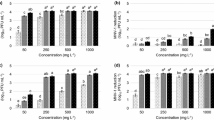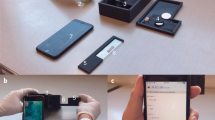Abstract
A method for studying the behavior of viruses on surfaces has been developed and is illustrated by determining the temperatures that inactivate adsorbed viral hemorrhagic septicemia virus (VHSV) and the concentration of 1-propanol that disinfected surfaces with adsorbed VHSV and chum salmon virus (CSV). VHSV is a rhabdovirus; CSV, a reovirus, and they were detected with two fish cell lines, EPC and CHSE-214, respectively. When polystyrene tissue culture surfaces were incubated with virus, rinsed, and left to dry, they still supported the attachment and spreading of cell lines and after 7 days these cells showed the characteristic CPE of the viruses. Thus cells appeared to be infected directly from surfaces on which viruses had been adsorbed. Applying this property to 96-well plates allowed duplicate surfaces to be examined for their infectiousness or support of CPE. For each treatment 80 replicate surfaces in a 96-well plate were tested at one time and the results expressed as the number of wells showing CPE. VHSV adsorbed to polystyrene was inactivated by drying in the dark at temperatures above 14 °C, but remained infectious for at least 15 days of drying at 4 °C. For chemical sterilization of polystyrene surfaces with adsorbed virus, disinfection was achieved with 1-propanol at 40% for VHSV and at 60% for CSV. As CPE can be conveniently monitored in 96-well plates with a fluorescence plate reader, this method can be used to rapidly evaluate a variety of treatments for their ability to inactivate surface-bound viruses.



Similar content being viewed by others
References
Abad FX, Pinto RM, Diez JM, Bosch A (1994) Disinfection of human enteric viruses in water by copper and silver in combination with low levels of chlorine. Appl Environ Microbiol 60:2377–2383
Bean B, Moore BM, Sterner B, Peterson LR, Gerding DN, Balfour HH (1982) Survival of influenza-viruses on environmental surfaces. J Infect Dis 146:47–51
Bellamy K (1995) A review of the test methods used to establish virucidal activity. J Hosp Infect Suppl 30:389–396
Belliot G, Lavaux A, Souihel D, Agnello D, Pothier P (2008) Use of marine norovirus as a surrogate to evaluate resistance of human norovirus to disinfectants. Appl Environ Microbiol 74:3315–3318
Berman D, Hoff JC (1984) Inactivation of simian rotavirus SA11 by chlorine, chlorine dioxide, and monochloramine. Appl Environ Microbiol 48:317–323
Bitton G (1980) Adsorption of viruses to surfaces: technological and ecological implications. In: Bitton G, Marshall KC (eds) Adsorption of microorganisms to surfaces. Wiley, New York, pp 332–374
Bols NC, Mosser DD, Steels GB (1992) Temperature studies and recent advances with fish cells in vitro. Comp Biochem Physiol 103A:1–14
Cantarero LA, Butler JE, Osborne JW (1980) The adsorptive characteristics of proteins for polystyrene and their significance in solid-phase immunoassays. Anal Biochem 105:375–382
Ferrier A, Garin D, Crance JM (2004) Rapid inactivation of vaccinia virus in suspension and dried on surfaces. J Hosp Infect 54:73–79
Fijan N, Sulimanovic D, Bearzotti M, Muzinic D, Zwillenberg Lo, Chilmonczyk S, Vautherot JF, Dekinkelin P (1983) Some properties of the epithelioma-papulosum-cyprini (EPC) cell-line from carp cyprinus-carpio. Annales De Virologie 134:207–220
Gerba CP (1984) Applied and theoretical aspects of virus adsorption to surfaces. Adv Appl Micro 30:133–168
Hawley L, Garver K (2008) Stability of viral hemorrhagic septicemia virus (VHSV) in freshwater and seawater at various temperatures. Dis Aquat Org 82:171–178
Inouye S (1973) Nonspecific adsorption of proteins to microplates. Appl Microbiol 25:279–283
Karber G (1931) Beitrag zur kollektiven Behandlung pharmakologischer Reihenversuche. Arch Exp Pathol 162:480–483
Kurita J, Lida Y, Nakajima K, Inouye K (2002) Virucidal effects of various disinfectants on viral hemorrhagic septicemia virus (VHSV) isolated from Japanese flounder. Fish Pathol 37:175–181
Lipson SM, Stotzky G (1986) Effect of kaolinite on the specific infectivity of reovirus. FEMS Microbiol Lett 37:83–88
Liu XY, Collodi P (2002) Novel form of fibronectin from zebrafish mediates infectious hematopoietic necrosis virus infection. J Virol 76:492–498
Lumsden JS, Morrison B, Yason C, Russell S, Young K, Yazdanpanah A, Huber P, Al-Hussinee L, Stone D, Way K (2007) Mortality event in freshwater drum Aplodinotus grunniens from Lake Ontario, Canada, associated with viral haemorrhagic septicemia virus, Type IV. Dis Aquat Org 76:99–111
Macinga DR, Sattar SA, Jaykus L, Arbogast JW (2008) Improved inactivation of nonenveloped enteric viruses and their surrogates by a novel alchohol-based hand sanitizer. Appl Environ Microbiol 74:5047–5052
Mbithi JN, Springthorpe VS, Sattar SA (1990) Chemical disinfection of hepatitis A virus on environmental surfaces. Appl Environ Microbiol 56:3601–3604
Mbithi JN, Springthorpe VS, Sattar SA (1991) Effect of relative humidity and air temperature on survival of hepatitis A virus on environmental surfaces. Appl Environ Microbiol 57:1394–1399
Mo C, Yamagata R, Pan A, Reddy J, Hazari N, Duke G (2008) Development of a high-throughput alamar blue assay for the determination of influenza virus infectious dose, serum antivirus neutralization titer and virus ca/ts phenotype. J Virol Methods 150:63–69
Nollert P, Kiefer H, Jahnig F (1995) Lipid vesicle adsorption versus formation of planar bilayers on solid-surfaces. Biophys J 69:1447–1455
Pasquardini L, Lunelli L, Vanzetti L, Anderle M, Pederzolli C (2008) Immobilization of cationic rifampicin-loaded liposomes on polystyrene for drug-delivery applications. Colloids Surf B Biointerfaces 62:265–272
Patnayak DP, Prasad M, Malik YS, Ramakrishnan MA, Goyal SM (2008) Efficacy of disinfectants and hand sanitizers against avian respiratory viruses. Avian Dis 52:199–202
Reybrouck G (1998) The testing of disinfectants. Int Biodeterior Biodegradation 41:269–272
Sattar SA, Springthorpe VS, Karim Y, Loro P (1989) Chemical disinfection of non-porous inanimate surfaces experimentally contaminated with four human pathogenic viruses. Epidem Inf 102:493–505
Savage CE, Jones RC (2003) The survival of avian reoviruses on materials associated with the poultry house environment. Avian Pathol 32:419–425
Schaub SA, Sagik BP (1975) Association of enteroviruses with natural and artificially introduced colloidal solids in water and infectivity of solids-associated virions. Appl Microbiol 30:212–222
Terpstra FG, van den Blick AE, Bos LM, Boots AGC, Brinkhuis FHM, Gijsen E, van Remmerden Y, Schuitemaker H, Wout AB (2007) Resistance of surface-dried virus to common disinfection procedures. J Hosp Infect 66:332–338
Thomas Y, Vogel G, Wunderli W, Suter P, Witschi M, Koch D, Tapparel C, Kaiser L (2008) Survival of influenza on banknotes. Appl Environ Microbiol 74:3002–3007
Thompson SS, Yates MV (1999) Bacteriophage inactivation at the air-water-solid interface in dynamic batch systems. Appl Environ Microbiol 65:1186–1190
Townsend E, Halvorson DA, Nagaraja KV, Shaw DP (2000) Susceptibility of an avian pneumovirus isolated from Minnesota turkeys to physical and chemical agents. Avian Dis 44:336–342
Ward RL, Ashley CS (1977) Inactivation of enteric viruses in wastewater-sludge through dewatering by evaporation. Appl Environ Microbiol 34:564–570
Yoshinaka T, Yoshimizu M, Ezura Y (2000) Adsorption and infectivity of infectious hematopoietic necrosis virus (IHNV) with various solids. J Aquat Anim Health 12:64–68
Acknowledgments
The research was supported by a Discovery Grant from the Natural Sciences and Engineering Research Council (NSERC) of Canada to Niels Bols. The authors thank Dr. John Lumsden U of Guelph for VHSV.
Author information
Authors and Affiliations
Corresponding author
Rights and permissions
About this article
Cite this article
Pham, P.H., Jung, J. & Bols, N.C. Using 96-well tissue culture polystyrene plates and a fluorescence plate reader as tools to study the survival and inactivation of viruses on surfaces. Cytotechnology 63, 385–397 (2011). https://doi.org/10.1007/s10616-011-9355-8
Received:
Accepted:
Published:
Issue Date:
DOI: https://doi.org/10.1007/s10616-011-9355-8




